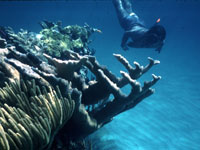 Jennifer Moore, a sophomore at Youngstown State University, spent her spring break conducting research in the Bahamas for her tropical geology course.
Jennifer Moore, a sophomore at Youngstown State University, spent her spring break conducting research in the Bahamas for her tropical geology course.
Moore is one of 17 YSU students who made the nine-day trip. She said she was “super excited” to do research outside of the U.S., especially since the trip was her first time leaving the country (with the exception of Canada).
During their trip, students stayed at the Gerace Research Centre at the College of the Bahamas, which is located on the north end of San Salvador Island. The college offers laboratory facilities, dining options, and housing for both students and faculty members.
Students hiked, snorkeled, explored limestone caverns and conducted pollution research on the beach.
Ron Shaklee, a geography professor and the director of the University Scholars and Honors Programs, brought his first class to the Bahamas in 1988, his second year at YSU. He has been conducting research on San Salvador Island since 1984, and has also written about the island for several publications.
“If we haven’t brought over 1,000 students down, we’re pretty damn close,” he said. “Taking these trips during the college years is the optimum time that we can do good things. You get so old that mobility becomes a problem.”
Shaklee said his geography classes “do a little bit of everything.” For instance, students observed living ecosystems by examining relationships between the island’s water and climates, as well as by studying different types of rocks.
Shaklee said it’s important not only to learn the science, but to also build relationships with the island’s hosts.
“The cross-cultural interaction gives students great insights into the lives, problems and concerns of people from a very different culture,” he said. “We all get to experience that complex web of life.”
Marie Adams, a sophomore at YSU, said she hasn’t flown since she was 7 years old, but that she was ready for her second visit to the Bahamas. The trip gave her a chance to study life and rock formations that aren’t available in Ohio.
“There’s a lot of stuff you can’t do around here. In class we learned a lot about the different kinds of fish. There will [be] some dangerous fish there, like barracudas,” Adams said. “They’re the really long fish with big teeth — the ones that ate the mom in ‘Finding Nemo.’”
By Justin Carissimo
News Editor, The Jambar
